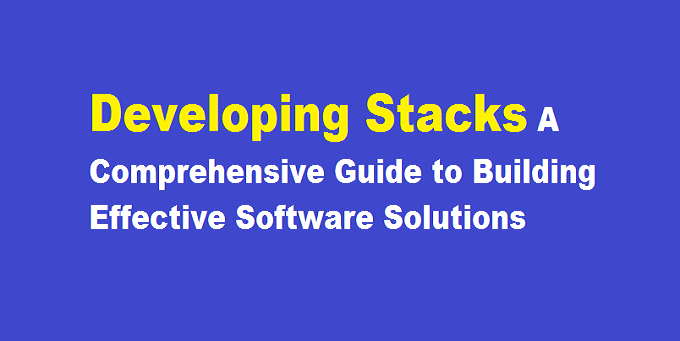Developing Stacks A Comprehensive Guide to Building Effective Software Solutions
4 min read
Introduction
In the world of software development, stacks play a crucial role in building robust and efficient applications. A stack refers to a collection of technologies, frameworks, and tools that work together to create a seamless software solution. In this article, we will delve into the process of developing stacks, exploring key considerations and best practices. Whether you’re a beginner or an experienced developer, this guide will provide valuable insights into creating effective stacks that meet the evolving needs of modern software development.
Understanding the Concept of Stacks
Before diving into the development process, it’s important to grasp the concept of stacks. In software development, a stack typically refers to a combination of programming languages, frameworks, libraries, databases, and other tools that work collectively to build a complete software solution. Stacks can be tailored for specific purposes such as web development, mobile app development, data analysis, and more. A well-designed stack ensures seamless integration of various components and facilitates efficient development, scalability, and maintenance of software applications.
Analysing Project Requirements
The first step in developing a stack is to analyse the project requirements thoroughly. Understand the goals and objectives of the software solution, identify the target audience, and determine the functional and non-functional requirements. Consider factors such as performance, scalability, security, and ease of maintenance. This analysis will help in selecting the appropriate technologies and tools for your stack.
Choosing the Right Technologies
Once you have a clear understanding of the project requirements, it’s time to choose the technologies that align with your goals. Research and evaluate different programming languages, frameworks, and libraries based on factors like popularity, community support, documentation, and performance. Consider using industry-standard tools and frameworks that have proven track records and vibrant developer communities. Additionally, ensure that the technologies you choose are compatible with each other to avoid potential integration challenges down the line.
Architecting the Stack
An effective stack architecture is essential for building a scalable and maintainable software solution. Define the layers of your stack, including the presentation layer, business logic layer, and data layer. Determine the interaction between these layers and choose appropriate frameworks and tools for each layer. Adopting a modular approach will enable easier maintenance and future enhancements. It is also crucial to consider scalability, fault tolerance, and security aspects while designing the stack architecture.
Ensuring Integration and Compatibility
Smooth integration between different components of the stack is vital for efficient development. Verify the compatibility of the chosen technologies, libraries, and frameworks, ensuring they can seamlessly communicate with each other. Test the integration at various stages of development to identify and address any compatibility issues early on. Additionally, pay attention to the compatibility of the stack with the target deployment environment, such as the operating system, server infrastructure, and other dependencies.
Staying Updated and Evolving
The field of software development is constantly evolving, with new technologies and frameworks emerging regularly. Stay updated with the latest trends and advancements in the industry. Participate in developer communities, attend conferences, and engage in continuous learning. Regularly review and update your stack to incorporate newer, more efficient technologies and tools that can enhance the performance and functionality of your software solution.
FREQUENTLY ASKED QUESTIONS
Define stack?
A Stack is a container of objects that are inserted and removed according to the last-in first-out (LIFO) principle. In the pushdown stacks only two operations are allowed: push the item into the stack, and pop the item out of the stack.
Why are stacks useful?
They’re very useful because they afford you constant time operations when inserting or removing from the front of a data structure. One common use of a stack is in compilers, where a stack can be used to make sure that the brackets and parentheses in a code file are all balanced, i.e., have an opening and closing counterpart. Stacks are also very useful in evaluating mathematical expressions.
Conclusion (100 words)
Developing effective stacks requires careful planning, thoughtful selection of technologies, and a deep understanding of project requirements. By following the steps outlined in this guide, you can build robust and scalable software solutions that meet the needs of your target audience. Remember to stay updated with the evolving landscape of software development and be open to adopting new technologies when necessary. Developing stacks is an ongoing process that requires continuous learning and adaptation to deliver high-quality software solutions in today’s rapidly changing world.
Read Also : Mastering Back-End Development A Comprehensive Guide






